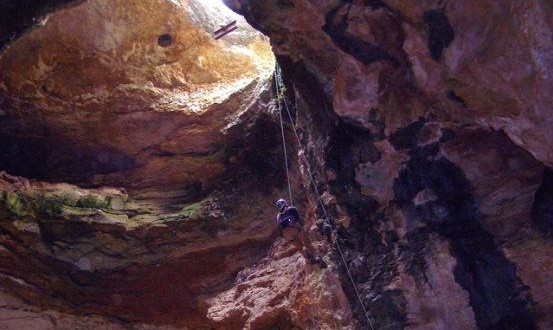Cheyenne – For the first time in more than 30 years, palaeontologists are about to revisit one of North America’s most remarkable troves of late Pleistocene fossils: The bones of tens of thousands of animals piled at least 9m deep at the bottom of a sinkhole-type cave.
Natural Trap Cave in north-central Wyoming is 25m deep and almost impossible to see until you’re standing right next to it. Over tens of thousands of years, many, many animals, including now-extinct mammoths, short-faced bears, American lions and American cheetahs shared the misfortune of not noticing the 4.5m wide opening until they were plunging to their deaths.
The cave was explored once before, in the mid 1970s, by a team from the University of Kansas but in the 1980s the U.S. Bureau of Land Management sealed over the entrance with a metal grate, and nobody has dared to venture inside since, until now.
Des Moines University paleontologist Julie Meachen said she has been getting ready to lead the international team of a dozen researchers and assistants by hitting the climbing gym.
‘I’m pretty terrified,’ Meachen admitted Wednesday.
She hasn’t done any real climbing before, she said, and the only way in is to rappel down. The only way out is an eight-story, single-rope climb all the way back up.
Even Bureau of Land Management regional paleontologist Brent Breithaupt, who isn’t one to be put off by lots of animal bones, describes it as a tad creepy.
‘One can only hope that, as a researcher, you’re able to leave,’ said Breithaupt, who visited the cave as a college student the last time it was open to scientists.
‘It’s an imposing hole in the ground. But one that actually has very important scientific value.’
However, braving the conditions will be worth it to give scientists what may be their best look yet at the variety of critters that roamed the foothills of the Bighorn Mountains during the planet’s last glacial period, around 25,000 years ago.
Some mammal remains from the cave could be over 100,000 years old, Breithaupt said.
The remote site is exceptionally well preserved. A mound of dirt and rock containing layer upon layer of animal bones rises from the floor of the bell-shaped chamber.
Meachen believes the remains will be in good enough condition to contain snippets of genetic information.
Co-investigator Alan Cooper with the Australian Centre for Ancient DNA at the University of Adelaide will attempt to retrieve fragments of mitochondrial DNA from the bones, Meachen said.
Such analysis wasn’t possible the last time scientists dug in the cave and could shed light on how the animals were related to their modern counterparts and each other.
‘It’s so cold all year long, that it has got just the perfect conditions for preserving DNA, in multiple species, in large numbers of individuals,” Meachen said.
‘Which is not really found anywhere except Siberia and the Arctic.’
Starting Monday, scientists will lower dig lights into the cave, powered by a generator on the surface, before dropping in to re-explore the cavern, dig and extract as many fossils over a two-week period as possible.
Agencies/Canadajournal

 Canada Journal – News of the World Articles and videos to bring you the biggest Canadian news stories from across the country every day
Canada Journal – News of the World Articles and videos to bring you the biggest Canadian news stories from across the country every day

